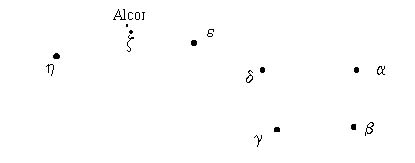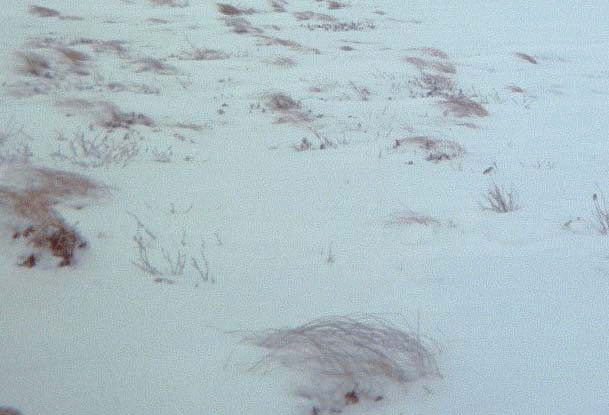Navigating
Reference Position - On November 10th at 10:00pm, Fred George began his first trip across the tundra for the winter. At that moment, the Big Dipper was over the northern horizon, like a giant spoon sitting on a table. Scientists identify the seven stars (from right to left), as alpha, beta, gamma, delta, epsilon, zeta, and eta.

| Symbol | Name | Meaning |
|---|---|---|
|
alpha |
Dubhe |
Bear |
|
beta |
Merak |
Flank of the Bear |
|
gamma |
Phecda |
Thigh |
|
delta |
Megrez |
Root of the Tail |
|
epsilon |
Alioth |
unknown |
|
zeta |
Mizar [Alcor] |
Horse[and Rider] |
|
eta |
Alkaid |
Leader of the Mourning Daughters |
On November 10th at 10:00 pm, in Akiachak, Gamma is directly over north on the horizon. This position of the dipper is a reference position for Fred George. It is the initial position for navigating with the Dipper in the coming winter months.
Before leaving Akiachak, Fred carefully checked his snow machine for gas and working parts. He loaded his machine with his hunting equipment; dressed warmly, and started his snow machine shortly before 10 pm on November. He travelled out of the village using the northbound snow machine trails.
Away from the village, at 10 pm, Fred stoped his snow machine to check the time on his watch and the position of Tunturyuk.
Hand Measurements - Fred George checked this position of the third star, Gamma, in the Big Dipper with a sequence of hand measurements. He uses his right "hand span", with the tip of his thumb at Gamma and his pinky pointing down to the horizon. Fred kept the tip of his pinky in stable position while closing his fingers and rotating his hand downward using "four-finger measurement." He keeps the index finger in stable position and rotates his hand downward using "three-finger measurement", which puts the index finger at the horizon. The tip of his index finger locates true north on the horizon.
Insert Diagram
Itinery - He choose one of two routes which lead to his fish camps. If the weather has little or no snow falling nor strong winds blowing, he will choose to travel to the Northwest fish camp by heading in the direction under the Dipper handle on November 10 at 10 pm. This direction turns out to be just under 30 degrees west of north.
He traveled on his snow machine between twenty four and thirty two kilometers per hours (15 - 20 MPH). The prevailing Northeast winds have created waves in the countless lakes between the Kuskokwim River and the Yukon River. Lakes freeze with a wavy surface, much like a frozen ocean. The October snow piles on the lakes, and changing temperatures cause the snow to melt and thaw frequently. This makes the snow snow harden, creating snow waves rolling in the Southwest direction on every lakes.
Fred's snow machine rides over the snow waves in rhythmic motion, which Fred feels kinesthetically with his body. If the snow machine changes its direction Fred can feel a change in the rhythmic motion. He learned to maintain the rhythmic motion to retain his course.
When he exits a lake and travels on land (tundra), Fred must use the frozen grass and wind blown trees as compasses. The prevailing Northeast winds cause the long blades of grass to lean over in the southwest direction, snow freezes the grass in leaning in the southwest direction. Few trees exist on the tundra. The few trees are generally in iscolated spots. The heavy winds cause the trees to lean in the south west direction and to grow most of its branches and leaves on the south west side of the tree, leaving the north east side of the tree barren.
Fred, also recognizes landmarks. Landmarks are rivulets, streams, and small structures, or tiny log houses. Fred identified a partially fallen 10 feet by 10 feet log cabin used in the old days by Yupiak hunters. Such landmarks appear occasionally along his pathway to fish camp. Mary George, says that, the locating landmarks is essential to navigating across the tundra. They reinforce the navigators understanding of his position on his journey.
After riding the tundra for two hours, Fred stops his snow machine to check his watch and the Big Dipper. Its midnight and the Big Dipper have moved to the left, i.e., counterclockwise 30 degrees. The end of Dipper handle is directly over true north. The Dipper appears to be turning upward. Fred places his watch in front of his chest with the 12 in the north direction and the 6 in the south direction. Fred checks his snow machine is heading 5 minutes to the left of north, i.e. 30 degrees west of north. With the 12 heading toward the dipper handle hovering over true north his snow machine must head in the direction of 11 on his watch, or 5 minutes to the left of north, which is 30 degrees northwest of north.
He checks the landmarks recognizing the frozen streams, and distant mountains. The strongest winds come from the northeast direction. On the first day of snow the wind blows the grass in one direction. Generally the grass is blown to the southwest. The weight of the snow holds the grass in the direction of the wind and the cold temperatures freeze the grass. Frozen grass becomes a natural compass on the tundra. Fred can use the grass to determine his direction.

Isolated trees are blown by the northeast winds. The tree is unable to grow branches on its northeast trunk. Its branches develop in the southwest direction. Such trees help Fred determine his way across the tundra.
By 2 AM the Dipper handle has turned upward. Another two hours has past and its time for Fred to check his watch and the Big Dipper. The Dipper handle has moved to the right. It appears parallel to a North direction. Fred will hold his two hands up so that one is in the north direction and the other is in the direction of the dipper handle.
If the weather is very bad, Fred waits until the storm is over. The elders do not travel in stormy weather. If a storm comes when they are out on the tundra, they build a snow cave to wait out the storm. This is one reason why weather prediction skills are so important to develop starting at the young age of 8 years old. Young boys are told to observe the weather at sunrise and sunset everyday. A skilled elder can predict the weather for the next 12 months.
If the weather is moderate with some snow fall, clouds and wind, Fred will travel due north for two hours and turn north east under the dipper handle, toward is other fish camp on the Yukon River. By 12 midnights the dipper has moved to the right and the dipper handle is over true north.
3.1.3 Equipment: Snow Machine, watch, and hands
Tundra is land covered with low bushes, and few trees. The high grass blows in the direction of the wind. The first snow covers the high grass pressing close to the ground. The cold temperatures freeze the grass into position. On the tundra Fred George uses the frozen grass to find direction.
The continuous strong winds from the northeast blow the trees toward the southwest causing the foliage to grow most densely in the southwest direction of the tree. The northeast side of the tree will not have any branches or leafs. Fred George uses these isolated trees to find his way.
The tundra has countless number of lakes between the Kuskokwim and the Yukon Rivers. Every lake has been given a Yup'ik name. The lake names are family names given to the lake for the family's historic use of the lake for fishing and camping. The northeast winds make waves in every lake. The waves freeze in position. The October snow falls over the frozen waves and becomes hard snow; making snow waves rolling in the southwest direction over the lakes Fred George uses the snow waves to find his direction. He feels the waves kinesthetically with the movement of his snow machine traveling over the waves. Fred relies heavily on the snow waves when the sky becomes overcast or the weather is somewhat stormy. If the weather is too stormy he stops and waits for the storm to pass.
On clear or even partially cloudy nights Fred uses the Big Dipper and Venus to find his way. In the fall of 1999 Venus was a morning star. He uses the Dipper in the late evening and Venus in the morning. It crossed over around Christmas and New Years Day. Through January 2000 to March 2000 Venus was the evening star. In February and March Fred used Venus in the evening and snow waves to return in the morning.
Venus has several Yup'ik names. The Akiachak name is Unuakum Agyartaa. Manokotak village people call Venus, Agyrapak. Other villages use Agesqurpak. Venus rotates about the sun inside the Earth's Orbit. When Venus is to the right of the sun it raises in the morning before the sun. It is brighter than any star, so as it raises it marks the east direction.
In fall 1999 Fred used the morning star to return to Akiachak in the following manner. He checks his watch. The morning star is in the East and should be on his left side when he faces south. Facing south he places his watch in front of his chest, so that 9 marks the east direction, 12 marks the south direction and 3 marks the west direction. Fred knows that Akiachak would be 5 minutes east of south, i.e., in the direction of 11 on his watch, which is 30 degrees east of south.
Heading 5 minutes to east of South Fred feels the motion of his snow machine over the snow waves. He maintains the motion to keep in the direction of Akiachak. The snow waves are perpendicular to the Southwest direction. Since his snow machine is traveling southeast. The left side of the front end rises up first, tilling the snow machine down on the right side. As the snow machine goes over the top, the tilt reversed itself. So as the machine slides over the snow waves, the left front tills up, while the right front tilts downward. This motion simulates a boat rocking in the ocean.
Fred cannot only see the snow waves, but he feels the snow waves with his body. He understands the motion kinesthetically. So in the darkness, in the heavy overcast and stormy weather Fred can navigate across the tundra feeling the motion of his snow machine over the snow waves.






